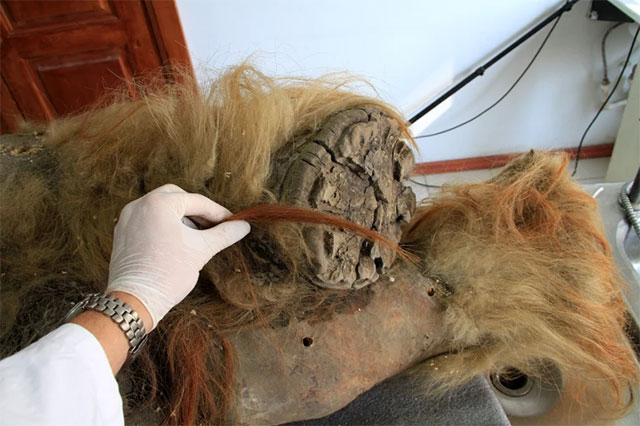The first 3D structural chromosome was discovered on fossil mammoth skin
On skin samples obtained from the animal perfectly preserved in permafrost, researchers discovered chromosomes preserved in their original 3D configuration - a feat previously achieved thought to be impossible in ancient DNA research.
This study is the first to report the 3D structure of an ancient genome. Because the spatial structure of the genome – an organism's complete 'set of genetic material' – holds clues about its gene activity, understanding the structure can yield deeper insights about the cell biology of mammoth skin, compared to just testing the DNA sequence as usual. This is an unprecedented feat.
Blurred marks of time
About 40 years ago, scientists discovered that bits of DNA could exist in samples from the distant past, including Egyptian mummies thousands of years old. Since then, it has been recognized that in many ancient relics, DNA is still preserved.
'However, over time, DNA degrades and is chemically damaged, so in the past researchers could only get DNA fragments that lacked a coherent structure,' said geneticist Erez Lieberman Aiden from the University of Baylor Texas Medical School, said. 'Reconstructing a 3D genome from such fragments of DNA is almost impossible: mammalian genomes are 30 million times the size of a typical piece of ancient DNA.'
Additionally, an intact chromosome – a single, long DNA molecule containing part of an organism's genetic material – is about a million times longer than most ancient DNA fragments. Due to the assumption that the 3D structure of DNA will disappear over time, no one has tried to study the organization of chromosomes in the nuclei of ancient cells.
Incredible discovery
Challenging that assumption, Lieberman Aiden and colleagues embarked on a nine-year research project to find the best preserved ancient samples. After nearly a decade, scientists finally found nearly intact chromosomes in 52,000-year-old skin samples of a woolly mammoth (Mammuthus primigenius) excavated from permafrost in Siberia. Study co-author Cynthia Pérez Estrada, a geneticist at Baylor College of Medicine, said the finding was 'amazing'.

The team then analyzed the mammoth chromosome structure and revealed the folding of the DNA molecule and its spatial organization in the nucleus – two features that are important in determining which genes are 'activated' and for how long.
Comparison with modern elephants, the mammoth's closest living relatives, not only shows similarities in chromosome number and structure but also shows differences in the activity of genes related to hair growth and adaptation to cold weather.
Specifically, for the first time scientists determined that woolly mammoths had 28 pairs of chromosomes, similar to modern elephants. This is also the first time scientists have been able to count the number of chromosomes of a long-extinct animal.
'Frozen DNA'
Researchers hypothesize that this mammoth's chromosomes were preserved in a glass-like state through a dehydration process similar to that used to produce beef jerky. This technique creates tissue in which DNA molecules are densely packed and immobile.
The team's experiments on freeze-dried beef, which subjected it to harsh tests that included being shot with a gun and run over by a car, confirmed the researchers' theory: the jerky fell apart. like glass but its chromosomes are still intact.
This present shows the potential for recovering ancient DNA far beyond what was previously thought possible, provided the conditions are ideal.
 The super unique 3-button keyboard for coders has just added an RGB light version
The super unique 3-button keyboard for coders has just added an RGB light version How to view song lyrics on Spotify
How to view song lyrics on Spotify Samsung Galaxy Tab S10: Configuration, expected launch time
Samsung Galaxy Tab S10: Configuration, expected launch time Successfully edited the genes of intestinal bacteria in living mice
Successfully edited the genes of intestinal bacteria in living mice Organisms with the largest 'population' on Earth
Organisms with the largest 'population' on Earth 5 must-have free Chrome extensions for students
5 must-have free Chrome extensions for students